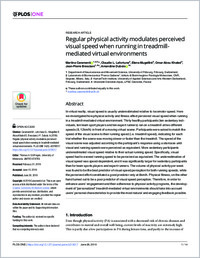Regular physical activity modulates perceived visual speed when running in treadmill-mediated virtual environments
- Caramenti, Martina Department of Neuroscience and Movement Science, University of Fribourg, Switzerland - Laboratorio di Biomeccanica “Franco Saibene”, Istituto di Bioimmagini e Fisiologia Molecolare, CNR, Segrate, Milano, Italy - HumanTech Institute, University of Applied Sciences and Arts Western Switzerland, Fribourg, Switzerland
- Lafortuna, Claudio L. Laboratorio di Biomeccanica “Franco Saibene”, Istituto di Bioimmagini e Fisiologia Molecolare, CNR, Segrate, Milano, Italy
- Mugellini, Elena HumanTech Institute, University of Applied Sciences and Arts Western Switzerland, Fribourg, Switzerland
- Khaled, Omar Abou HumanTech Institute, University of Applied Sciences and Arts Western Switzerland, Fribourg, Switzerland
- Bresciani, Jean-Pierre Department of Neuroscience and Movement Science, University of Fribourg, Switzerland - Universite´ Grenoble-Alpes, LPNC Grenoble, France
- Dubois, Amandine Department of Neuroscience and Movement Science, University of Fribourg, Switzerland
- 26.06.2019
Published in:
- PLOS ONE. - 2019, vol. 14, no. 6, p. e0219017
English
In virtual reality, visual speed is usually underestimated relative to locomotor speed. Here we investigated how physical activity and fitness affect perceived visual speed when running in a treadmill-mediated virtual environment. Thirty healthy participants (ten sedentary individuals, ten team sport players and ten expert runners) ran on a treadmill at two different speeds (8, 12km/h) in front of a moving virtual scene. Participants were asked to match the speed of the visual scene to their running speed (i.e. treadmill speed), indicating for each trial whether the scene was moving slower or faster than the treadmill. The speed of the visual scene was adjusted according to the participant’s response using a staircase until visual and running speeds were perceived as equivalent. More sedentary participants underestimated visual speed relative to their actual running speed. Specifically, visual speed had to exceed running speed to be perceived as equivalent. The underestimation of visual speed was speed- dependent, and it was significantly larger for sedentary participants than for team sports players and expert runners. The volume of physical activity per week was found to be the best predictor of visual speed perception for both running speeds, while the perceived effort constituted a good predictor only at 8km/h. Physical fitness, on the other hand turned out to be a poor predictor of visual speed perception. Therefore, in order to enhance users’ engagement and their adherence to physical activity programs, the development of “personalized” treadmill-mediated virtual environments should take into account users’ personal characteristics to provide the most natural and engaging feedback possible.
- Faculty
- Faculté des sciences et de médecine
- Department
- Département de Médecine
- Language
-
- English
- Classification
- Biological sciences
- License
- License undefined
- Identifiers
-
- RERO DOC 327438
- DOI 10.1371/journal.pone.0219017
- Persistent URL
- https://folia.unifr.ch/unifr/documents/308262
Other files
Statistics
Document views: 55
File downloads:
- bre_rpa.pdf: 177
- bre_rpa_sm.txt: 41

